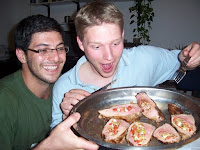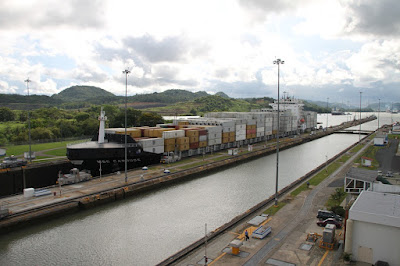We have already warned you that we would post yet another "beach"-episode. If you have had enough of our beach stories (admittedly, they can get repetitive in that they mostly involve sand, sea, sun, and hop-based beverages), you might be relieved to hear that this will be our last beach post for quite some time to come.
Previously, we shared some of our experiences at the beaches of Southern Brazil, as well as on the Panamanian paradise-like San Blas islands. This time around, we would like to tell you a bit about our time at the other parts of the Caribbean & Pacific coasts in Panama & Costa Rica, as well as some of the stuff we did when travelling in between coasts.
Again, starting in a chronological order: as Central-to-Northern Europeans, it's in our genes to have problems coping with sustained average temperatures over 28°C. Therefore, following our stay in San Blas, we decided to escape the heat by heading to the central Panamanian highlands and cloud forests. We stayed at a truly remote mountain hostel in between the towns of David and Bocas del Toro, which can only be reached by foot. In fact, the hostel is so remote that the water and electricity supply regularly shuts down. Nevertheless, we enjoyed wearing pullovers for a change. The rest of the time, we went hiking, and tried to avoid the snakes when going to the toilet (Judith almost stumbled onto one at night, and Lene saw a very poisonous (i.e. deadly) specimen crossing our hiking track (snakes that is, not toilets)).
Previously, we shared some of our experiences at the beaches of Southern Brazil, as well as on the Panamanian paradise-like San Blas islands. This time around, we would like to tell you a bit about our time at the other parts of the Caribbean & Pacific coasts in Panama & Costa Rica, as well as some of the stuff we did when travelling in between coasts.
Again, starting in a chronological order: as Central-to-Northern Europeans, it's in our genes to have problems coping with sustained average temperatures over 28°C. Therefore, following our stay in San Blas, we decided to escape the heat by heading to the central Panamanian highlands and cloud forests. We stayed at a truly remote mountain hostel in between the towns of David and Bocas del Toro, which can only be reached by foot. In fact, the hostel is so remote that the water and electricity supply regularly shuts down. Nevertheless, we enjoyed wearing pullovers for a change. The rest of the time, we went hiking, and tried to avoid the snakes when going to the toilet (Judith almost stumbled onto one at night, and Lene saw a very poisonous (i.e. deadly) specimen crossing our hiking track (snakes that is, not toilets)).
 Having had cooled down, we again headed for the beach, this time to the Caribbean archipelago of Bocas del Toro. Bocas features a marine national park, but in recent years, a Mallorca Ballermann/ Torremolinos/ Spring Break-like backpacker party tourism apparently has caught on strongly. We didn't get to see a lot of the latter though, since we moved on to a more tranquil island (being almost 30 and all). Once more, we were lucky to stay at a really cool hostel, where you could see the seawater below when looking through the cracks in the wooden floor.
Having had cooled down, we again headed for the beach, this time to the Caribbean archipelago of Bocas del Toro. Bocas features a marine national park, but in recent years, a Mallorca Ballermann/ Torremolinos/ Spring Break-like backpacker party tourism apparently has caught on strongly. We didn't get to see a lot of the latter though, since we moved on to a more tranquil island (being almost 30 and all). Once more, we were lucky to stay at a really cool hostel, where you could see the seawater below when looking through the cracks in the wooden floor. After Bocas, we crossed the border into Costa Rica, continuing to stay at the Caribbean coast. The Panamanian and the Costa Rican Caribbean coastal towns have a very cool atmosphere to them – people are very laid back, and you can find reggae, rastafaris, and cool surfer dudes* everywhere. Instead of Spanish, most locals there speak a Jamaican-style English, which almost sounds Creole (basically we didn't understand a word they were saying, but I'm sure they were nice things).
Eventually, it was time to say goodbye not only to the Caribbean, but also to Judith's sister Lene, who was to fly back to Germany. Lene had been the best travel buddy imaginable for the past two months – Lene, you rock!
Having loved the Costa Rican East Coast, Judith & I wanted to give the West Coast (i.e. the Pacific side) a chance, too. We first took the bus to Dominical, a surfer town consisting of a dirt road, empty surf shops, empty restaurants, and empty hostels – somehow, we got the odd feeling it could be low season. The most memorable moment of our stay in Dominical was the little earthquake we got to witness - 5.0 on the Richter scale, with the epicenter being a mere 50 km away.
After several days, we continued on to the town and national park of Manuel Antonio (it's not a guy, I swear, it's a place). The town of Manuel Antonio has seen a huge amount of construction of hotels in recent years, and is very much dominated by (US-American & European) foreigners who bought up most of the land. Compared to our experiences in South America earlier, the national park itself seemed a bit 'kindergarten', but we did see a lot of monkeys and enjoyed the nice beaches.


The route back to San José was beautiful. We got to see a lot of the amazingly green and lush mountain ranges, riding on buses which reached an average speed of 25 km/h (I'm being serious) on the long and winding roads.
Overall, Costa Rica is a very nice place to visit. The country is relatively safe by Central American standards, and the landscapes and coastlines are fabulous. Unfortunately, we're not the first ones to notice that. Tourism is highly developed here and prices reflect that. If you want, you can have 4-5 star accommodation and point-to-point air-conditioned transport, not speaking a word of Spanish during all of your stay. It's still possible to see a more original version of the country off the beaten track, though. The Ticos (Costa Ricans) we met were all friendly and very much appreciated us speaking Spanish (some of them even made fun of our Castellano-accents - how dare they?), which enabled us to find out a lot more about their history and culture than we would have otherwise.
Now, we are sitting in our hostel in San José, playing pool, and waiting for our flight tomorrow. Where to? Vegas, baby!!! And as far as you are concerned, Latin America: you have been very kind to us, thank you. We will miss you.
___________________________________________________________________________
*Btw, I'm thinking of letting my hair grow long for the duration of this trip to look like one of 'em cool surfers. Comments & suggestions are highly appreciated (for the sake of this highly important discussion, the comment function is now open to non-registered users, too)







































